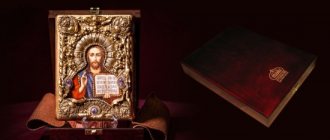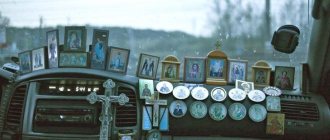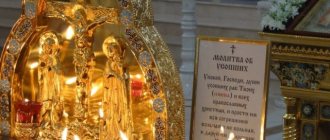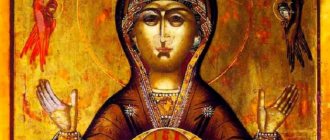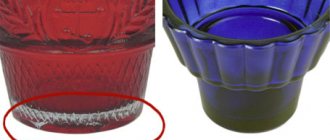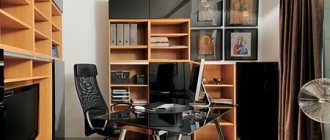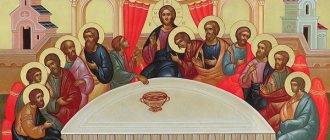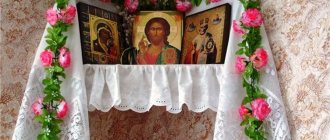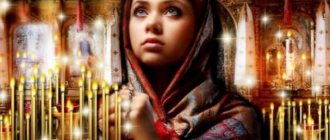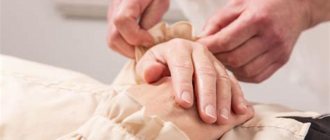Even in Domostroy it was stated that every Christian believer should have a place at home where he could pray and be alone with God. In Orthodoxy, it is believed that the house is a continuation of the temple, therefore the placement of holy images here is allowed and even encouraged. The iconostasis must be located where it will be clearly visible. This should not be a secluded corner, but one of the main places in the apartment. Residents of modern apartments must adhere to this rule if they strive for a righteous life.
Installation of an iconostasis in the house
The arrangement of icons in a home iconostasis can be arbitrary, but in the Christian tradition there are some rules.
In past times, every family had a shelf where holy images were displayed. These divine paintings were located in the brightest and most eye-catching place. The shelf for icons was installed in the far corner of the house, in the East. This place was the most illuminated, since the two walls forming it had windows, where a lot of sunlight passed through.
Home iconostasis
An icon is a sacred image, which is separated from everyday realities and never mixes with everyday life, but is intended exclusively for dialogue with the Lord. It is a window from the infinite world, as well as divine revelations in the tones and lines of the icon painter’s brush.
It is naive to assume that a large number of holy images makes the life of an Orthodox believer more pious than it actually is.
About icons:
- Is it possible to put icons in the bedroom
- Who paints icons for the church and how?
- How to choose wedding icons
An unsystematized collection of icons, various reproductions, and church calendars is similar to ordinary collecting, where prayer completely disappears as an end in itself. Here there is a complete distortion of the term “house”, which is a continuation of the monastery.
How to decorate
The use of additional decorative elements helps transform a home iconostasis. It is important not to add a lot of decorations so that the main focus is on the sacred paintings.
Natural flowers
It is allowed to place fresh flowers or willow branches next to the icons. Dried flowers are immediately removed from the shelves.
Lamp
The lamp is a small vessel with a wick filled with oil. The light of the lamp represents the invisible Divine light and is lit next to sacred images. You can place several lamps next to the most revered icons and light them before reading the prayer.
Cross
A cross is almost always placed at the top of the iconostasis. You cannot place it below or alongside the canvases. The size of the cross is selected taking into account the dimensions of the icons and additional church paraphernalia.
Use of reproductions
Reproductions of icons with high-quality images are allowed to be placed in the iconostasis, but only during consecration in the church. Paper reproductions are glued onto a solid wooden base and covered with a thin layer of varnish. Apply the coating with care, as the varnish can damage the printing ink. To prevent reproductions from fading over time, you will need to protect them from exposure to sunlight.
Modern location of the iconostasis
For a family, this relic is a unifying prayer factor that arises after the forgiveness of all everyday grievances and the achievement of mutual understanding.
- Today's realities of life insist that the church allows you to set up a home iconostasis in a free place. However, orthodox rules recommend placing it on the eastern side. The concept of “east” has an important feature for Orthodoxy. It is written about him in the Book of Genesis, in Bartholomew and Matthew.
- If doors are located in the east of the apartment, it is allowed to use other cardinal directions.
- When choosing a place for a family altar, you need to avoid the proximity of holy images with any household appliances, which are considered a vain product of modernization and do not contribute to spirituality. It is necessary to avoid close proximity of icons and decorative decorations, as well as with books of a non-religious nature.
- For an Orthodox family, the presence of images of the Savior Christ and the Virgin Mary in the home iconostasis is mandatory. The image of the Messiah should always remain central, and all others will be smaller in size. The main icons (Trinity, Christ and the Virgin Mary) are located above the others, but the Crucifixion is allowed to be placed above them.
How to correctly arrange icons in an apartment
- Decoration for the family iconostasis - fresh flowers. Large icons installed nearby should be framed with towels according to the ancient Christian tradition. It is prohibited to place non-canonical paintings or their reproductions nearby.
- The home iconostasis should be crowned with a cross, and a lamp should be lit during prayerful praise. On holidays, according to the church calendar, candle flames can burn for a whole day.
Important: enough space should be left in front of the iconostasis so that believers do not feel crowded during a family prayer service.
How to make it yourself
You can make an iconostasis for your home or apartment yourself, following step-by-step instructions. The dimensions and number of shelves are determined individually, depending on the number of selected images. To make a standard shelf with two tiers, perform the following steps:
- Use a marker or pencil to mark on wooden pieces. The outer edges of the shelves are drawn in the form of a semicircle, a decorative figure, or left straight.
- They cut out parts from the boards with a jigsaw, after which they sand the workpieces with sandpaper.
- To hold the shelves, supports are made from small flat planks.
- Using self-tapping screws, the shelves are fixed to the supports and then connected to each other. To strengthen the joints, they are coated with wood glue.
- Metal hinges are attached to the back of the shelves, and holes are made on the wall for dowels and mounting bolts.
- The shelf is covered with stain or wood varnish. After the applied material has dried, the product is hung on fasteners.
Holy images for the goddess
There must be two holy images in the home iconostasis.
An image of the Son of God, testifying to the incarnation of God and the salvation of the human race. For prayer, a waist cloth is often chosen, on which the Almighty blesses the world with his right hand, and holds the Divine Scripture in his left hand. The Lord appears in these images as the Arbiter of every destiny, a merciful Father who gives the Truth to which the eyes of Orthodox followers are directed. In this regard, icons of the Son of God always occupy the main place on the shelves of the home iconostasis.
The face of the Mother of God, who is a perfect man and revered above the Seraphim and Cherubim. More often, images called “Tenderness” or “Hodegetria” are used.
- The author of the first type, whose lists are extremely common in the Orthodox world, is traditionally considered to be the Apostle Luke. In “Tenderness” there is a magnificent contact between Christ in infancy and the Mother of God, which symbolizes the union of the earthly and the heavenly, the Creator and the best of His creations. The image expresses the Creator’s infinite love for the human race, when God gave the Son to atone for sinfulness. The most common and famous icons of the “Tenderness” type include: Vladimir, “It is Worthy to Eat,” “Recovery of the Dead,” etc.
- “Hodegetria” (“Guide”) is the second common type of face of the Virgin Mary. The image demonstrates the true path to God. On the icon this is evidenced by the specific gesture of the right hand of the Mother of God, pointing to the Infant Christ. The most famous faces of “Hodegetria” are: Blachernae, Iveron, Tikhvin, Kazan, etc.
Read about the Mother of God icons for the iconostasis:
- "Tikhvinskaya"
- "Kazanskaya"
- "Iverskaya"
In the Orthodox tradition, the image of St. Nicholas the Pleasant is extremely popular. It has always occupied an important place on the shelves of every Christian's iconostasis. St. Nicholas is revered as an eternal servant of God, endowed with special grace.
An Orthodox Christian can place in the shrine the images of the famous prophet Elijah, the Great Martyr George the Victorious, Panteleimon, and the holy evangelist John the Baptist.
Advice! The choice is always individual, and the best assistant in the matter is the priest. They turn to him or another monk for advice.
Iconostasis in the house
Common Mistakes
When arranging the iconostasis, people who have superficial knowledge of church paraphernalia often make mistakes. The most common ones include:
- placing secular objects next to sacred images - figurines, cosmetics, household appliances and various decorative items;
- a combination of divine paintings with non-icon paintings, calendars and posters;
- an excessive number of images, because of which the place for prayer seems crowded, and the atmosphere of calm and solitude is lost;
- violation of hierarchy when arranging paintings on shelves.
Special placement instructions
At home, you are allowed to follow only the basic rules of placement.
- It is necessary to maintain symmetry and systematicity, to think through the compositional structure, which will help avoid feelings of internal dissatisfaction and the desire to change something. Incorrect arrangement distracts from the prayer service, the essence of which is concentration on petition and praise.
- An Orthodox person is obliged to remember the principle of church hierarchy: locally revered icons cannot be placed above the main ones (Christ the Savior, the Virgin Mary and the Holy Trinity).
- The image of the Messiah must be placed on the right side of the upcoming believer, and the canvas with the face of the Virgin Mary on the left. When selecting an iconostasis, one should focus on the uniformity of artistic execution of the shrines. The Church is not recommended to allow diversity in styles.
- Orthodox people must take holiness very seriously, since it is one of the properties of God himself. This quality is reflected in heavenly saints and material objects. It follows: the veneration of holy governors and iconographies belongs to the same religious order.
- The degree of churching of a family is judged by the reverence that members show to the faces of Christ and the Mother of God. Ancestral icons have always been greatly revered. The newly baptized baby was brought to the shrine, and the priest read prayers praising God. In ancient times, through the icon, parents blessed their children for successful studies, travel to distant lands, and service to society. Before a wedding or after the death of a person, believers also turned to the saints for help.
- If an iconostasis is placed in the house, quarrels, disgusting behavior, and scandals on various topics are unacceptable. However, an overly reverent attitude towards shrines should not be transformed into idolatry. We must remember: icons are a divine image, but not the very personality of the Lord or His vicegerents.
- A canvas that has fallen into complete disrepair and cannot be restored cannot be thrown away; it must be treated with due respect and respect as an ancient tablet. Previously, if the colors on an icon were washed off, it was sent down the river. Today, such a rarity is taken to the church, where it is burned in the temple oven.
- If damage to the face occurred due to careless storage, one should confess, since the Church considers such irresponsibility a sin.
Important!
The Savior, the Mother of God, the apostles and saints looking from the canvases belong to eternity. When asking them for intercession through prayer, we - residents of areas of sorrow - need to always remember the Almighty Creator, the call to voluntary repentance, self-improvement and mercy. Through the eyes of saints, the Almighty looks at people and reminds us that we have the opportunity to save our souls. Orthodox online store Svyatsy.Org - iconostases for the home.
Making elements of the future shelf
The future do-it-yourself corner shelf for icons consists of several elements. Namely from:
- side panels;
- shelves;
- racks;
- sides.
Determine the dimensions based on what shape you have, as well as where the structure will be located.
It can be straight or angular. Today we are interested in the second option. Although straight shelves are easier to make. As is the case with wall flower shelves.
